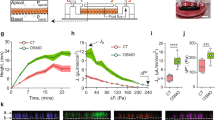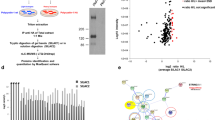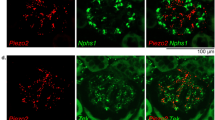Abstract
Autosomal dominant polycystic kidney disease is a common disorder, affecting approximately one in 1,000 individuals. This disease is characterized by the presence of renal and extrarenal cysts, as well as by cardiovascular abnormalities, including hypertension and intracranial aneurysms. Mutations in the PKD1 gene account for 85% of cases, whereas mutations in PKD2 account for the remaining 15% of cases. Findings from the past 10 years indicate that polycystins, the products of the PKD genes, have a key role in renal and vascular mechanosensory transduction. In the primary cilium of renal, nodal, and endothelial cells, polycystins are proposed to act as flow sensors. In addition, the ratio of polycystin-1 to polycystin-2 regulates pressure sensing in arterial myocytes. In this Review, we summarize the data indicating that polycystins are key molecules in mechanotransduction. Moreover, we discuss the role of nucleotide release and autocrine and/or paracrine purinergic signaling in both fluid flow and pressure responses. Finally, we discuss the possible role of altered mechanosensory transduction in the etiology of polycystic kidney disease.
Key Points
-
The polycystin receptor–ion channel complex formed by polycystin-1 and polycystin-2 is localized in the primary cilium and is necessary for flow sensing in both renal epithelial and endothelial cells
-
Bending of the primary cilium by fluid flow is anticipated to induce a conformational change in the polycystins, which results in calcium influx
-
Fluid flow induces the cilium-dependent release of nucleotides and the autocrine and/or paracrine stimulation of purinergic receptors; pressure induces the cilium-independent release of ATP
-
Activation of the endothelial primary cilium polycystin complex by fluid flow mediates nitric oxide release, causing vasodilation
-
Polycystin-2 in nodal sensory cilia is involved in determination of left–right asymmetry
-
The ratio of polycystin-1 to polycystin-2 regulates the opening of stretch-activated ion channels in arterial myocytes and affects myogenic tone
This is a preview of subscription content, access via your institution
Access options
Subscribe to this journal
Receive 12 print issues and online access
$209.00 per year
only $17.42 per issue
Buy this article
- Purchase on Springer Link
- Instant access to full article PDF
Prices may be subject to local taxes which are calculated during checkout






Similar content being viewed by others
References
Delmas, P. Polycystins: from mechanosensation to gene regulation. Cell 118, 145–148 (2004).
Wilson, P. D. Polycystic kidney disease. N. Engl. J. Med. 350, 151–164 (2004).
Zhou, J. Polycystins and primary cilia: primers for cell cycle progression. Annu. Rev. Physiol. 71, 83–113 (2009).
Harris, P. C. & Torres, V. E. Polycystic kidney disease. Annu. Rev. Med. 60, 321–337 (2009).
Delmas, P. Polycystins: polymodal receptor/ion-channel cellular sensors. Pflugers Arch. 451, 264–276 (2005).
Voets, T. & Nilius, B. TRPs make sense. J. Membr. Biol. 192, 1–8 (2003).
Clapham, D. E. TRP channels as cellular sensors. Nature 426, 517–524 (2003).
Nauli, S. M. & Zhou, J. Polycystins and mechanosensation in renal and nodal cilia. Bioessays 26, 844–856 (2004).
Nauli, S. M. et al. Polycystins 1 and 2 mediate mechanosensation in the primary cilium of kidney cells. Nat. Genet. 33, 129–137 (2003).
Nauli, S. M. et al. Endothelial cilia are fluid shear sensors that regulate calcium signaling and nitric oxide production through polycystin-1. Circulation 117, 1161–1171 (2008).
Aboualaiwi, W. A. et al. Ciliary polycystin-2 is a mechanosensitive calcium channel involved in nitric oxide signaling cascades. Circ. Res. 104, 860–869 (2009).
McGrath, J., Somlo, S., Makova, S., Tian, X. & Brueckner, M. Two populations of node monocilia initiate left-right asymmetry in the mouse. Cell 114, 61–73 (2003).
Pennekamp, P. et al. The ion channel polycystin-2 is required for left-right axis determination in mice. Curr. Biol. 12, 938–943 (2002).
Sharif Naeini, R. et al. Polycystin-1 and -2 dosage regulates pressure sensing. Cell 139, 587–596 (2009).
Fliegauf, M., Benzing, T. & Omran, H. When cilia go bad: cilia defects and ciliopathies. Nat. Rev. Mol. Cell Biol. 8, 880–893 (2007).
Hildebrandt, F. & Otto, E. Cilia and centrosomes: a unifying pathogenic concept for cystic kidney disease? Nat. Rev. Genet. 6, 928–940 (2005).
Badano, J. L., Mitsuma, N., Beales, P. L. & Katsanis, N. The ciliopathies: An emerging class of human genetic disorders. Annu. Rev. Genomics Hum. Genet. 7, 125–148 (2006).
Praetorius, H. A. & Spring, K. R. Bending the MDCK cell primary cilium increases intracellular calcium. J. Membr. Biol. 184, 71–79 (2001).
Praetorius, H. A. & Spring, K. R. A physiological view of the primary cilium. Annu. Rev. Physiol. 67, 515–529 (2005).
Praetorius, H. A. & Spring, K. R. Removal of the MDCK cell primary cilium abolishes flow sensing. J. Membr. Biol. 191, 69–76 (2003).
Forman, J. R., Qamar, S., Paci, E., Sandford, R. N. & Clarke, J. The remarkable mechanical strength of polycystin-1 supports a direct role in mechanotransduction. J. Mol. Biol. 349, 861–871 (2005).
Qian, F., Wei, W., Germino, G. & Oberhauser, A. The nanomechanics of polycystin-1 extracellular region. J. Biol. Chem. 280, 40723–40730 (2005).
Kottgen, M. et al. TRPP2 and TRPV4 form a polymodal sensory channel complex. J. Cell Biol. 182, 437–447 (2008).
Tsiokas, L. et al. Specific association of the gene product of PKD2 with the TRPC1 channel. Proc. Natl Acad. Sci. USA 96, 3934–3939 (1999).
Maroto, R. et al. TRPC1 forms the stretch-activated cation channel in vertebrate cells. Nat. Cell Biol. 7, 179–185 (2005).
Gottlieb, P. et al. Revisiting TRPC1 and TRPC6 mechanosensitivity. Pflugers Arch. 455, 529–540 (2007).
Rohatgi, R. et al. Mechanoregulation of intracellular Ca2+ in human autosomal recessive polycystic kidney disease cyst-lining renal epithelial cells. Am. J. Physiol. Renal Physiol. 294, F890–F899 (2008).
Fischer, E. et al. Defective planar cell polarity in polycystic kidney disease. Nat. Genet. 38, 21–23 (2006).
Jonassen, J. A., San Agustin, J., Follit, J. A. & Pazour, G. J. Deletion of IFT20 in the mouse kidney causes misorientation of the mitotic spindle and cystic kidney disease. J. Cell Biol. 183, 377–384 (2008).
Wu, G. et al. Cardiac defects and renal failure in mice with targeted mutations in Pkd2. Nat. Genet. 24, 75–78 (2000).
Wu, G. et al. Somatic inactivation of Pkd2 results in polycystic kidney disease. Cell 93, 177–188 (1998).
Lu, W. et al. Perinatal lethality with kidney and pancreas defects in mice with a targetted Pkd1 mutation. Nat. Genet. 17, 179–181 (1997).
Boulter, C. et al. Cardiovascular, skeletal, and renal defects in mice with a targeted disruption of the Pkd1 gene. Proc. Natl Acad. Sci. USA 98, 12174–12179 (2001).
Piontek, K., Menezes, L. F., Garcia-Gonzalez, M. A., Huso, D. L. & Germino, G. G. A critical developmental switch defines the kinetics of kidney cyst formation after loss of Pkd1. Nat. Med. 13, 1490–1495 (2007).
Davenport, J. R. et al. Disruption of intraflagellar transport in adult mice leads to obesity and slow-onset cystic kidney disease. Curr. Biol. 17, 1586–1594 (2007).
Karcher, C. et al. Lack of a laterality phenotype in Pkd1 knock-out embryos correlates with absence of polycystin-1 in nodal cilia. Differentiation 73, 425–432 (2005).
Vogel, P. et al. Situs inversus in Dpcd/Poll−/−, Nme7−/−, and Pkd1l1−/− mice. Vet. Pathol. 47, 120–131 (2010).
Bichet, D., Peters, D., Patel, A., Delmas, P. & Honoré, E. The cardiovascular polycystins: insights from autosomal dominant polycystic kidney disease and transgenic animal models. Trends Cardiovasc. Med. 16, 292–298 (2006).
Ecder, T. & Schrier, R. W. Cardiovascular abnormalities in autosomal-dominant polycystic kidney disease. Nat. Rev. Nephrol. 5, 221–228 (2009).
Torres, V. E. et al. Vascular expression of polycystin-2. J. Am. Soc. Nephrol. 12, 1–9 (2001).
Griffin, M. D., Torres, V. E., Grande, J. P. & Kumar, R. Vascular expression of polycystin. J. Am. Soc. Nephrol. 8, 616–626 (1997).
Qian, Q. et al. Analysis of the polycystins in aortic vascular smooth muscle cells. J. Am. Soc. Nephrol. 14, 2280–2287 (2003).
Persu, A. et al. Modifier effect of ENOS in autosomal dominant polycystic kidney disease. Hum. Mol. Genet. 11, 229–241 (2002).
Hahn, C. & Schwartz, M. A. Mechanotransduction in vascular physiology and atherogenesis. Nat. Rev. Mol. Cell. Biol. 10, 53–62 (2009).
Morel, N. et al. PKD1 haploinsufficiency is associated with altered vascular reactivity and abnormal calcium signaling in the mouse aorta. Pflugers Arch. 457, 845–856 (2008).
Qian, F., Watnick, T. J., Onuchic, L. F. & Germino, G. G. The molecular basis of focal cyst formation in human autosomal dominant polycystic kidney disease type I. Cell 87, 979–987 (1996).
Koulen, P. et al. Polycystin-2 is an intracellular calcium release channel. Nat. Cell Biol. 4, 191–197 (2002).
Praetorius, H. A. & Leipziger, J. Released nucleotides amplify the cilium-dependent, flow-induced [Ca2+]i response in MDCK cells. Acta Physiol. (Oxford) 197, 241–251 (2009).
Hovater, M. B. et al. Loss of apical monocilia on collecting duct principal cells impairs ATP secretion across the apical cell surface and ATP-dependent and flow-induced calcium signals. Purinergic Signal. 4, 155–170 (2008).
Xu, C. et al. Attenuated, flow-induced ATP release contributes to absence of flow-sensitive, purinergic Cai2+ signaling in human ADPKD cyst epithelial cells. Am. J. Physiol. Renal Physiol. 296, F1464–F1476 (2009).
Praetorius, H. A. & Leipziger, J. Fluid flow sensing and triggered nucleotide release in epithelia. J. Physiol. 586, 2669 (2008).
Leipziger, J. Control of epithelial transport via luminal P2 receptors. Am. J. Physiol. Renal Physiol. 284, F419–F432 (2003).
Vallon, V. P2 receptors in the regulation of renal transport mechanisms. Am. J. Physiol. Renal Physiol. 294, F10–F27 (2008).
Burnstock, G. Physiology and pathophysiology of purinergic neurotransmission. Physiol. Rev. 87, 659–797 (2007).
Yamamoto, K. et al. Impaired flow-dependent control of vascular tone and remodeling in P2X4-deficient mice. Nat. Med. 12, 133–137 (2006).
Praetorius, H. A., Frokiaer, J. & Leipziger, J. Transepithelial pressure pulses induce nucleotide release in polarized MDCK cells. Am. J. Physiol. Renal Physiol. 288, 133–141 (2009).
Derezic, D. & Cecuk, L. Hydrostatic pressure within renal cysts. Br. J. Urol. 54, 93–94 (1982).
Tanner, G. A., McQuillan, P. F., Maxwell, M. R., Keck, J. K. & McAteer, J. A. An in vitro test of the cell stretch-proliferation hypothesis of renal cyst enlargement. J. Am. Soc. Nephrol. 6, 1230–1241 (1995).
59. Lantinga- van Leeuwen, I. S. et al. Kidney-specific inactivation of the Pkd1 gene induces rapid cyst formation in developing kidneys and a slow onset of disease in adult mice. Hum. Mol. Genet. 16, 3188–3196 (2007).
Fetterman, G. H., Ravitch, M. M. & Sherman, F. E. Cystic changes in fetal kidneys following ureteral ligation: studies by microdissection. Kidney Int. 5, 111–121 (1974).
Quinlan, M. R., Docherty, N. G., Watson, R. W. & Fitzpatrick, J. M. Exploring mechanisms involved in renal tubular sensing of mechanical stretch following ureteric obstruction. Am. J. Physiol. Renal Physiol. 295, F1–F11 (2008).
Jensen, M. E., Odgaard, E., Christensen, M. H., Praetorius, H. A. & Leipziger, J. Flow-induced [Ca2+]i increase depends on nucleotide release and subsequent purinergic signaling in the intact nephron. J. Am. Soc. Nephrol. 18, 2062–2070 (2007).
Wilson, P. D., Hovater, J. S., Casey, C. C., Fortenberry, J. A. & Schwiebert, E. M. ATP release mechanisms in primary cultures of epithelia derived from the cysts of polycystic kidneys. J. Am. Soc. Nephrol. 10, 218–229 (1999).
Schwiebert, E. M. et al. Autocrine extracellular purinergic signaling in epithelial cells derived from polycystic kidneys. Am. J. Physiol. Renal Physiol. 282, F763–F775 (2002).
Hovater, M. B., Olteanu, D., Welty, E. A. & Schwiebert, E. M. Purinergic signaling in the lumen of a normal nephron and in remodeled PKD encapsulated cysts. Purinergic Signal. 4, 109–124 (2008).
Olteanu, D., Hovater, M. B. & Schwiebert, E. M. Intraluminal autocrine purinergic signaling within cysts: implications for the progression of diseases that involve encapsulated cyst formation. Am. J. Physiol. Renal Physiol. 292, F11–F14 (2007).
Brayden, J. E., Earley, S., Nelson, M. T. & Reading, S. Transient receptor potential (TRP) channels, vascular tone and autoregulation of cerebral blood flow. Clin. Exp. Pharmacol. Physiol. 35, 1116–1120 (2008).
Hill, M. A., Davis, M. J., Meininger, G. A., Potocnik, S. J. & Murphy, T. V. Arteriolar myogenic signalling mechanisms: Implications for local vascular function. Clin. Hemorheol. Microcirc. 34, 67–79 (2006).
Stossel, T. P. et al. Filamins as integrators of cell mechanics and signalling. Nat. Rev. Mol. Cell Biol. 2, 138–145 (2001).
Mochizuki, T. et al. PKD2, a gene for polycystic kidney disease that encodes an integral membrane protein. Science 272, 1339–1342 (1996).
Chen, X. Z. et al. Transport function of the naturally occurring pathogenic polycystin-2 mutant, R742X. Biochem. Biophys. Res. Commun. 282, 1251–1256 (2001).
Praetorius, H. A. & Leipziger, J. ATP release from non-excitable cells. Purinergic Signal. 5, 433–446 (2009).
Kobori, T., Smith, G. D., Sandford, R. & Edwardson, J. M. The transient receptor potential channels TRPP2 and TRPC1 form a heterotetramer with a 2:2 stoichiometry and an alternating subunit arrangement. J. Biol. Chem. 284, 35507–35513 (2009).
Yu, Y. et al. Structural and molecular basis of the assembly of the TRPP2/PKD1 complex. Proc. Natl Acad. Sci. USA 106, 11558–11563 (2009).
Bodin, P. & Burnstock, G. Purinergic signalling: ATP release. Neurochem. Res. 26, 959–969 (2001).
Acknowledgements
We are grateful to the ANR 2005 cardiovasculaire-obésité-diabète, to the ANR 2008 du gène à la physiopathologie, to the Association for information and research on genetic kidney disease France, to the Fondation del Duca, to the Fondation de la recherche médicale, to the Fondation de France, to the Fondation de recherche sur l'hypertension artérielle, to the Fédération pour la recherche sur le cerveau, to Société Générale AM, to the Université de Nice-Sophia Antipolis and to the CNRS for financial support. We are grateful to Dr Sophie Demolombe, Institute of Molecular and Cellular Pharmacology, CNRS, Valbonne Sophia Antipolis, France, for critical reading of the manuscript.
Author information
Authors and Affiliations
Contributions
A. Patel and E. Honoré contributed equally to researching data for the article, discussing content, writing, and reviewing/editing the manuscript before submission.
Corresponding author
Ethics declarations
Competing interests
The authors declare no competing financial interests.
Rights and permissions
About this article
Cite this article
Patel, A., Honoré, E. Polycystins and renovascular mechanosensory transduction. Nat Rev Nephrol 6, 530–538 (2010). https://doi.org/10.1038/nrneph.2010.97
Published:
Issue Date:
DOI: https://doi.org/10.1038/nrneph.2010.97
This article is cited by
-
Piezo channels in the urinary system
Experimental & Molecular Medicine (2022)
-
TRPP2 and STIM1 form a microdomain to regulate store-operated Ca2+ entry and blood vessel tone
Cell Communication and Signaling (2020)
-
Renal cyst growth is attenuated by a combination treatment of tolvaptan and pioglitazone, while pioglitazone treatment alone is not effective
Scientific Reports (2020)
-
Hippo signaling—a central player in cystic kidney disease?
Pediatric Nephrology (2020)
-
The emerging role of tubulin posttranslational modifications in cilia and ciliopathies
Biophysics Reports (2020)



